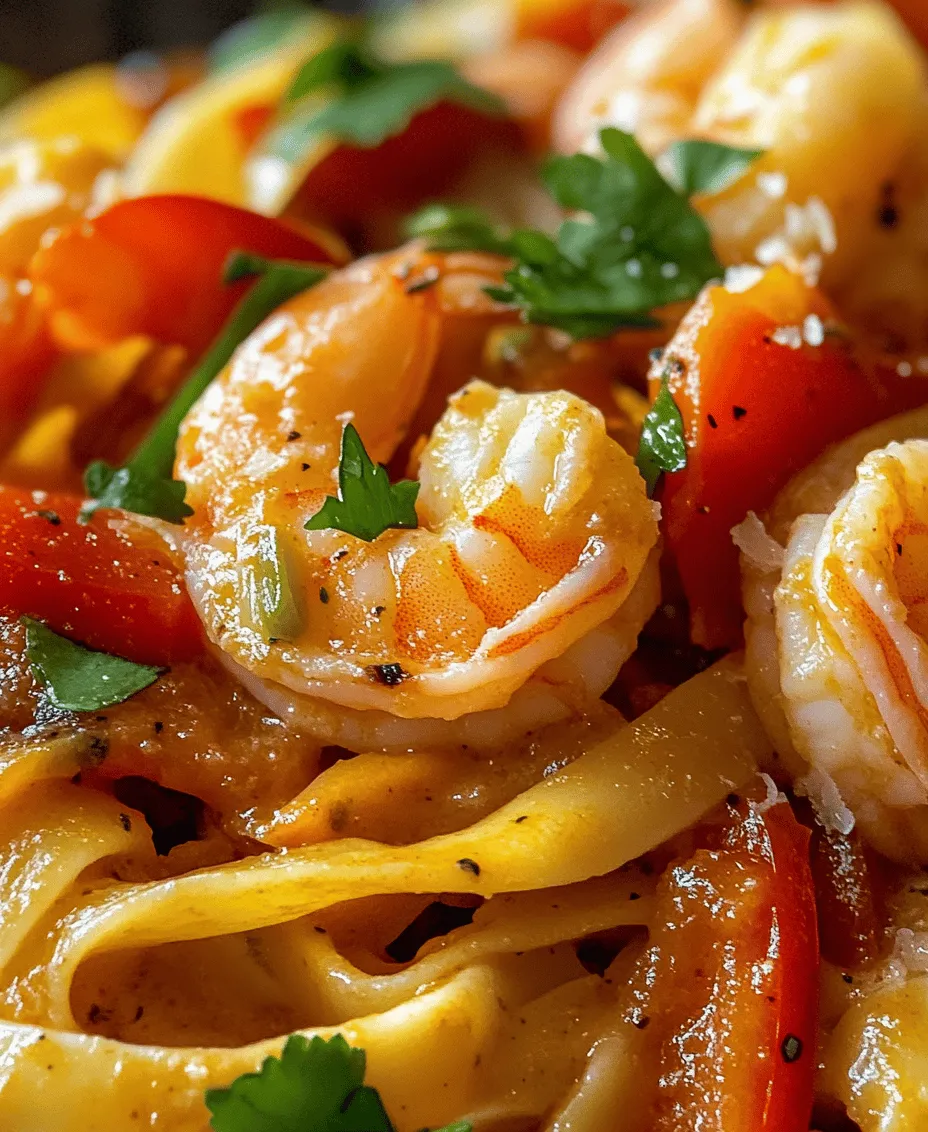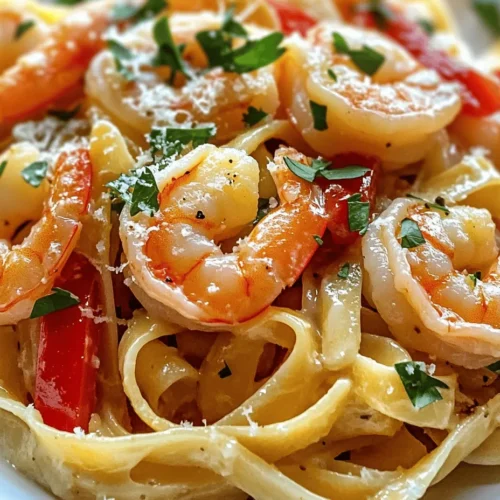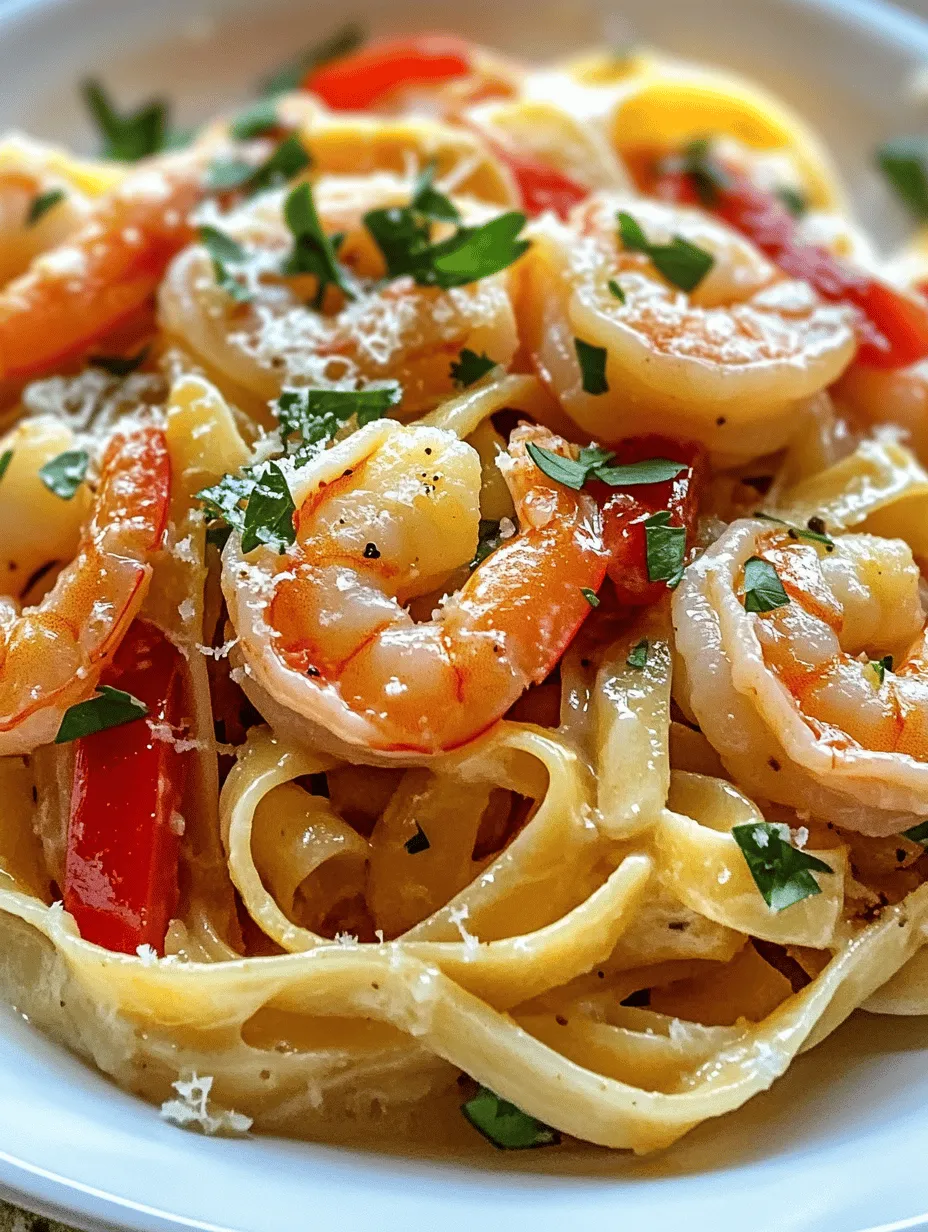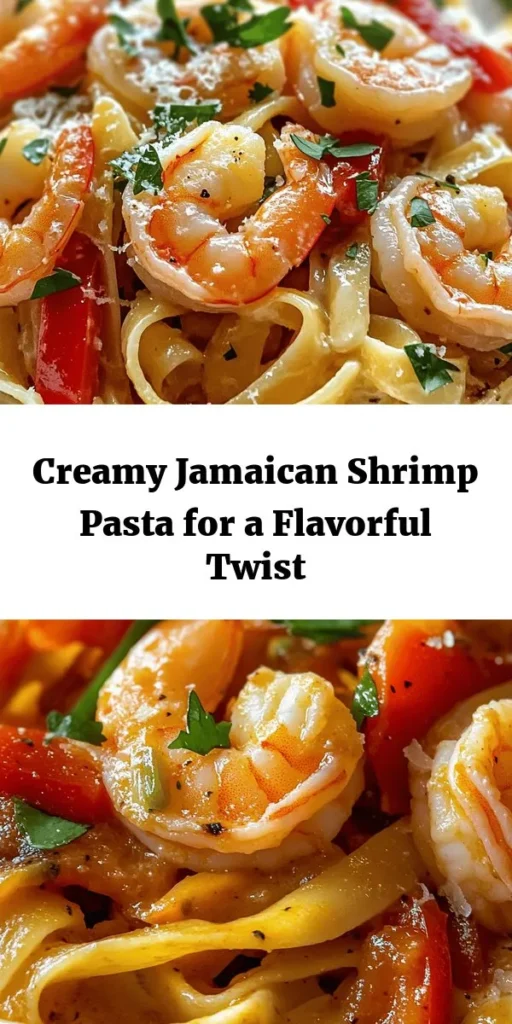Introduction
Jamaican cuisine is a vibrant tapestry of flavors, colors, and aromas that reflect the island’s rich cultural heritage. Known for its bold use of spices, fresh ingredients, and a delightful fusion of flavors, Jamaican cooking captures the essence of tropical life. From jerk chicken to curried goat, the island’s culinary repertoire is as diverse as its landscapes. One dish that beautifully embodies this spirit of fusion is Jamaican Shrimp Pasta—a delightful blend of classic Italian pasta and the tropical ingredients that make Jamaican cuisine so unique.
Jamaican Shrimp Pasta is not just a meal; it’s an experience that takes your taste buds on a journey. Infused with the creamy richness of coconut milk, zesty lime, and a medley of aromatic spices, this dish offers a harmonious combination of flavors that will transport you straight to the sun-soaked shores of Jamaica. It’s a perfect dish for those who appreciate the art of combining traditional recipes with modern cooking techniques.
The secret to achieving an authentic Jamaican Shrimp Pasta lies in using fresh, high-quality ingredients. The shrimp should be succulent and juicy, while the pasta must be cooked to perfection. Fresh herbs and spices play a crucial role in elevating the dish, giving it that unmistakable Jamaican flair. In this article, we’ll guide you through the process of creating this creamy delight, providing you with detailed recipe instructions, cooking techniques, and tips to ensure your dish is nothing short of spectacular.
Get ready to embark on a culinary adventure as we explore the ingredients that make this dish so special and dive into the step-by-step cooking instructions that will leave you with a plateful of creamy goodness.
Understanding the Ingredients
Key Ingredients in Jamaican Shrimp Pasta
To create a truly memorable Jamaican Shrimp Pasta, it’s essential to understand the role of each ingredient in the recipe. Here’s a closer look at the key components that will bring this dish to life.
Shrimp: Nutritional Benefits and Selection Tips
Shrimp is the star of this dish, providing not only a delicious source of protein but also a variety of essential nutrients. Rich in omega-3 fatty acids, vitamin B12, and selenium, shrimp is a healthy choice that supports heart health and boosts your immune system. When selecting shrimp for your pasta, opt for fresh, wild-caught shrimp whenever possible. Look for shrimp that has a firm texture, a slight ocean scent, and a translucent color. Avoid shrimp that appears dull or has an ammonia smell, as these can indicate poor quality.
For this recipe, medium to large shrimp works best, as their size allows for a satisfying bite while ensuring even cooking. If you’re using frozen shrimp, make sure to thaw them completely and pat them dry before cooking to achieve the best results.
Pasta: Types of Pasta Best Suited for This Dish
While you can use various types of pasta in this recipe, fettuccine and linguine are the most traditional choices that complement the creamy sauce beautifully. Fettuccine, with its wide, flat shape, holds onto the sauce, ensuring every bite is packed with flavor. Linguine, on the other hand, provides a slightly thinner profile that works well with the shrimp and sauce. Ultimately, the choice of pasta comes down to personal preference; both options will yield a delicious result.
Coconut Milk: Role in Flavor and Creaminess, Health Benefits
Coconut milk is a crucial ingredient in Jamaican Shrimp Pasta, providing a rich, creamy texture that enhances the dish’s tropical flavors. It adds a natural sweetness and depth that pairs perfectly with the spices and shrimp. Additionally, coconut milk is a dairy-free alternative, making this dish suitable for those who are lactose intolerant. It also contains medium-chain triglycerides (MCTs), which may support weight management and provide a quick source of energy.
When choosing coconut milk, look for brands that use minimal additives and preservatives. Full-fat coconut milk yields the creamiest results, but you can also use light coconut milk if you prefer a lower-calorie option. Just keep in mind that this may affect the overall richness of your sauce.
Spices: The Significance of Allspice, Smoked Paprika, and Cayenne in Jamaican Cooking
Jamaican cuisine is characterized by its bold and vibrant spices, and in Jamaican Shrimp Pasta, we harness the power of three key spices: allspice, smoked paprika, and cayenne.
– Allspice, often referred to as “pimento,” is a quintessential spice in Jamaican cooking, providing a warm, aromatic flavor reminiscent of cloves, cinnamon, and nutmeg. It adds depth to the dish and enhances the natural sweetness of the shrimp.
– Smoked paprika adds a subtle smokiness and a rich red hue to the pasta, complementing the tropical flavors and creating an inviting visual appeal.
– Cayenne pepper introduces a hint of heat, balancing the creaminess of the coconut milk without overpowering the dish. Adjust the amount based on your heat preference, starting with a smaller quantity and adding more as desired.
These spices not only enhance the flavor but also contribute to the overall experience of enjoying Jamaican cuisine.
Fresh Herbs: The Importance of Cilantro and Lime Juice
To finish off the dish, fresh herbs play an essential role in brightening the flavors. Cilantro is a staple in Jamaican cooking, offering a refreshing burst of flavor that complements the richness of the sauce. The addition of lime juice elevates the dish further, providing a zesty acidity that balances the creaminess of the coconut milk and the spices.
When using fresh herbs, always opt for the freshest options available. A quick rinse and chop right before serving will ensure that the flavors are vibrant and aromatic.
Step-by-Step Cooking Instructions
Now that we’ve covered the essential ingredients, it’s time to dive into the cooking process. Follow these detailed steps to create a flavorful Jamaican Shrimp Pasta that is sure to impress.
Cooking the Pasta
1. Bring a large pot of water to a boil: Fill a large pot with water and add a generous amount of salt. The salt is crucial, as it enhances the pasta’s flavor during cooking.
2. Add the pasta: Once the water is boiling, add your choice of pasta. For this recipe, fettuccine or linguine are ideal. Stir occasionally to prevent sticking.
3. Cook to al dente: Follow the package instructions for cooking time, but start checking for doneness a minute or two before the recommended time. You want the pasta to be al dente—cooked through but still firm to the bite.
4. Reserve pasta water: Before draining the pasta, reserve about a cup of the starchy cooking water. This water can be used later to adjust the sauce’s consistency, ensuring a creamy texture.
5. Drain the pasta: Drain the pasta in a colander, but do not rinse it. The starch on the pasta helps the sauce cling to it.
Sautéing Vegetables
1. Prepare your ingredients: While the pasta is cooking, gather your vegetables. Dice a medium onion, mince a few cloves of garlic, and slice bell peppers. Colorful bell peppers not only add flavor but also enhance the dish’s visual appeal.
2. Heat a skillet: In a large skillet, heat a drizzle of olive oil over medium heat. Make sure the pan is hot enough before adding the ingredients.
3. Begin with onions and garlic: Add the diced onions and minced garlic to the skillet. Sauté for about 2-3 minutes until the onions become translucent and fragrant. This step is crucial for building flavor, as the combination of onions and garlic forms a savory base for your sauce.
4. Add bell peppers: Once the onions and garlic are softened, add the sliced bell peppers. Sauté for an additional 2-3 minutes until the peppers are tender but still vibrant in color. Timing is essential here, as you want the peppers to retain some crunch for added texture in the final dish.
Cooking the Shrimp
1. Add the shrimp: Once the vegetables are sautéed, push them to the side of the skillet and add the shrimp. If your skillet is large enough, you can add them directly to the center.
2. Season the shrimp: Sprinkle the shrimp with salt, black pepper, allspice, smoked paprika, and cayenne. Ensure that the shrimp are evenly coated with the spices.
3. Cook the shrimp: Allow the shrimp to cook undisturbed for about 2-3 minutes on one side until they turn pink and opaque. Then, flip the shrimp to cook the other side for an additional 1-2 minutes. Be careful not to overcook the shrimp, as they can become tough and rubbery.
4. Remove from heat: Once the shrimp are cooked through, remove the skillet from the heat and set it aside.
Making the Sauce
1. Add coconut milk: With the skillet still warm, pour in the coconut milk, stirring to combine it with the sautéed vegetables and shrimp.
2. Incorporate the lime juice: Squeeze fresh lime juice into the sauce, adjusting the amount to your taste. The acidity from the lime will brighten the flavors and complement the richness of the coconut milk.
3. Adjust consistency: If the sauce is too thick, gradually add reserved pasta water until it reaches your desired consistency. The starchy water will help thicken the sauce while keeping it creamy.
4. Combine pasta and sauce: Finally, add the cooked pasta to the skillet with the sauce. Toss everything together to ensure the pasta is well-coated with the creamy sauce and evenly mixed with the shrimp and vegetables.
This step is where the magic happens, as the pasta absorbs the flavors of the sauce, creating a harmonious blend of tastes and textures.
Through these detailed steps, you’ll create a delicious Jamaican Shrimp Pasta that showcases the best of Jamaican cuisine while satisfying your cravings for a creamy pasta dish. Stay tuned for more cooking tips and techniques to elevate this dish further in the next part of our article.

Combining Coconut Milk and Heavy Cream: Balancing Flavors
The heart of Jamaican Shrimp Pasta lies in its creamy sauce, where coconut milk and heavy cream play a crucial role in achieving the perfect balance of flavors. Coconut milk brings a subtle sweetness and rich, tropical notes to the dish, while heavy cream adds a luxurious texture and depth. This combination creates a harmonious blend that complements the shrimp and spices beautifully.
To start, you’ll want to use full-fat coconut milk for the best flavor and creaminess. When you combine it with heavy cream, aim for a ratio that allows the coconut flavor to shine without being overpowering. A good rule of thumb is to use one cup of coconut milk and half a cup of heavy cream. This will provide the rich creaminess that makes each bite indulgent while keeping the dish light and flavorful.
The Simmering Process: How It Affects the Final Dish’s Texture and Taste
Simmering is a critical step in this recipe, as it allows the flavors to meld together while thickening the sauce. Begin by heating your sauce mixture over medium heat once you have combined the coconut milk and heavy cream. Bring it to a gentle simmer and allow it to bubble lightly—this encourages the ingredients to blend and develop more complex flavors.
During this process, the heat helps to evaporate some of the water content in the coconut milk, thickening the sauce and concentrating the flavors. Stir occasionally to prevent sticking and ensure even heating. The simmering process should take about 10-15 minutes; you’ll know it’s ready when the sauce has thickened slightly and clings to the back of a spoon.
Adjusting Sauce Consistency with Reserved Pasta Water
One of the chef’s secrets to achieving the perfect sauce consistency is using reserved pasta water. As you cook your pasta, save about a cup of the starchy water before draining. This water can be a game-changer when it comes to adjusting the sauce.
If your sauce appears too thick, simply add a few tablespoons of the reserved pasta water, stirring well to incorporate. The starch in the water not only helps to loosen the sauce but also binds it to the pasta, ensuring a creamy coating. Start with a small amount and gradually add more until you reach your desired consistency.
Combining Pasta and Sauce: Techniques for Even Coating
Once your pasta is cooked al dente, it’s time to combine it with the creamy sauce. First, drain the pasta and add it directly to the simmering sauce. Toss the pasta gently to coat it evenly. Using tongs can be particularly effective here, as they allow you to lift and fold the pasta into the sauce without breaking it apart.
For the best results, allow the pasta to simmer in the sauce for a minute or two. This not only ensures that the pasta absorbs some of the sauce’s flavor but also allows for a more cohesive dish. If you find that the pasta is not fully coated after mixing, feel free to add a splash of reserved pasta water to help the sauce cling better.
The Role of Lime Juice and Cilantro in Brightening the Dish
Before serving, don’t forget to add a splash of fresh lime juice and chopped cilantro to your dish. These ingredients are essential for brightening the flavors and adding a refreshing contrast to the richness of the sauce. The acidity from the lime juice cuts through the creaminess, making each bite feel lighter and more balanced.
Cilantro not only adds a pop of color but also infuses the dish with its unique herbal notes. To incorporate, squeeze the juice of half a lime over the finished pasta and toss in a generous handful of chopped cilantro. This final touch enhances the overall flavor profile and brings the essence of Jamaica to your plate.
Serving Suggestions
When it comes to presenting your Jamaican Shrimp Pasta, aim for a visually appealing display that highlights the dish’s vibrant colors and textures. Here are some ideas for how to serve it beautifully:
1. Presentation Ideas: Use a large, shallow bowl for serving. Twirl the pasta into a nest in the center, allowing the shrimp to sit atop, and drizzle extra sauce around the edges for a stunning visual effect. Garnish with additional cilantro and lime wedges for an added pop of color.
2. Suggested Pairings: To complement your meal, consider serving a light salad, such as a tropical fruit salad or a simple mixed greens salad with a citrus vinaigrette. For beverages, a chilled glass of white wine or a refreshing coconut water can enhance the dining experience.
3. Optional Garnishes: Enhance the visual appeal and flavor with optional garnishes. Toasted coconut flakes, for instance, can add crunch and an extra layer of coconut flavor. A sprinkle of red pepper flakes can provide a hint of heat for those who enjoy a bit of spice.
Nutritional Information
Understanding the nutritional profile of your dish is vital for maintaining a balanced diet. Here’s an overview of what to expect per serving of Jamaican Shrimp Pasta:
– Calories: Approximately 500-600 calories
– Protein: 25-30 grams (thanks to the shrimp)
– Carbohydrates: 60-70 grams (primarily from the pasta)
– Fats: 20-25 grams (from the coconut milk and heavy cream)
Potential Health Benefits of Ingredients Used
Jamaican Shrimp Pasta is not only delicious but also offers several health benefits:
– Shrimp: A great source of lean protein and low in calories, shrimp is packed with vitamins B12 and D, as well as selenium.
– Coconut Milk: Contains healthy fats that can help boost energy and may support heart health.
– Lime Juice: High in vitamin C, lime juice is excellent for immune support and adds a refreshing acidity to the dish.
– Cilantro: Rich in antioxidants, cilantro may aid digestion and help reduce inflammation.
Considerations for Dietary Restrictions
For those with dietary restrictions, this dish can easily be adapted:
– Gluten-Free Options: Substitute traditional pasta with gluten-free pasta made from rice, quinoa, or legume flour.
– Dairy Alternatives: For a dairy-free version, replace heavy cream with coconut cream or a non-dairy heavy cream alternative available in stores.
Exploring Variations of Jamaican Shrimp Pasta
One of the beautiful aspects of Jamaican cuisine is its versatility. Here are some ideas for variations you can explore:
1. Ingredient Substitutions: If shrimp isn’t your preference, consider using chicken, scallops, or even firm tofu for a vegetarian option. Each protein will bring its unique flavor to the dish.
2. Adaptation for Vegan or Vegetarian Diets: To make this dish vegan, swap out shrimp for sautéed vegetables like bell peppers, zucchini, and mushrooms. Use coconut cream instead of heavy cream and ensure that your pasta is egg-free.
3. Regional Variations: Jamaican cuisine is influenced by various cultures, allowing for creative twists on traditional recipes. Consider adding ingredients like jerk seasoning for a spicy kick, or incorporating local vegetables such as callaloo or ackee.
Cultural Significance of Jamaican Cuisine
Jamaican cuisine is a rich tapestry of flavors and traditions that reflect the island’s history and diverse influences. With roots in African, Indigenous, British, and Indian cooking, Jamaican food has evolved into a unique culinary identity.
Dishes like Jamaican Shrimp Pasta showcase the island’s use of fresh ingredients, bold spices, and a love for layering flavors. The combination of coconut, lime, and seafood is a celebration of the island’s bountiful coastline and agricultural heritage.
Conclusion
In summary, Jamaican Shrimp Pasta is a delightful dish that combines the lush flavors of the Caribbean with the comforting familiarity of pasta. The balance of coconut milk and heavy cream, complemented by lime juice and cilantro, creates a creamy yet vibrant sauce that enchants the palate.
Whether you’re making this dish for a cozy family dinner or a special gathering, it promises to impress with its rich flavor and visual appeal. Embrace the spirit of Jamaican cooking by exploring fresh ingredients and bold flavors, and enjoy the journey of creating this exquisite dish in your kitchen.



